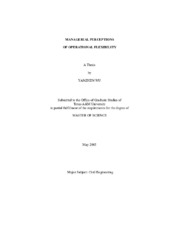| dc.description.abstract | Large complex construction projects such as building an interstate highway, a dam, a
chemical plant, an off-shore oil rig and a waste-to-energy plant often include
unpredictable geological conditions, labor supplies, material deliveries, and weather that
cause uncertainty. Effective and efficient acquisition and construction require the
proactive management of these and other uncertainties to meet performance, schedule,
and cost targets. Flexibility in the form of real options can be an effective tool for
managing uncertainty and thereby adding value to construction projects. But flexibility
can be expensive to obtain, maintain, and implement. Real options theory suggests a
general approach and has developed precise valuation models. But these models of
simplified real options (compared to managerial practice) have failed to significantly
improve practice, partially because of a lack of knowledge of real options use by
practicing managers. In contrast, the majority of managerial real options applications are
identified, designed, valued, and implemented tacitly by construction managers.
Understanding current practice and its similarities and differences with theory is critical
for developing operational real options theories that can improve construction practice.
Few descriptions of managerial real options practice exist as a basis for improvement.
To address this need the current research has experiment subjects manage a simple but
uncertain installation project with managerial flexibility. Subjects repeatedly value an
option to avoid a slow and expensive system integration failure. Real options theory is
used to explain their behaviors by customizing the model of uncertainty to reflect themanagement context.
To further analyze managerial real options practice, a system dynamics simulation model
of the experimental installation project is developed. Policies for using flexibility to
manage uncertainty that are applied by subjects are modeled and performances are
simulated across a range of uncertain conditions to evaluate and compare policy
effectiveness.
All 21 subjects that participated in the research perceived flexibility as an effective tool
in managing uncertain projects. But they are not aware of the factors that impact
flexibility value. They correctly identified the relationship of some factors with
flexibility value but not all of them and not the magnitude of impaction. Further research
and development needs for expanding real options theory into the operational
management of construction are discussed based on experiment and simulation results. | en |


